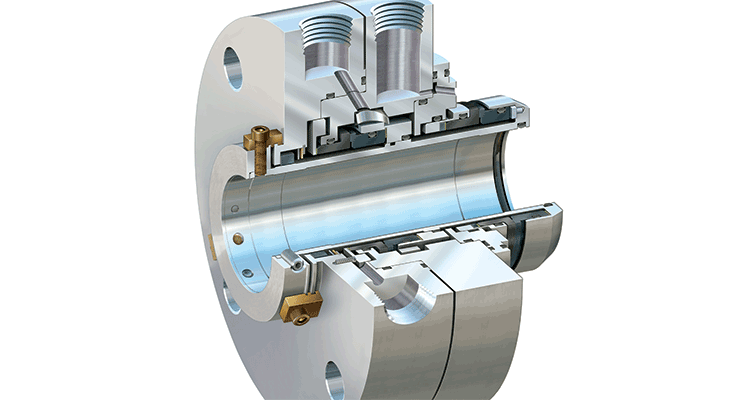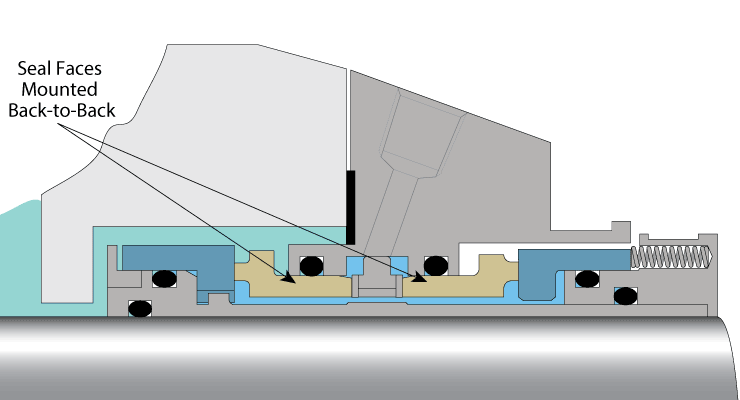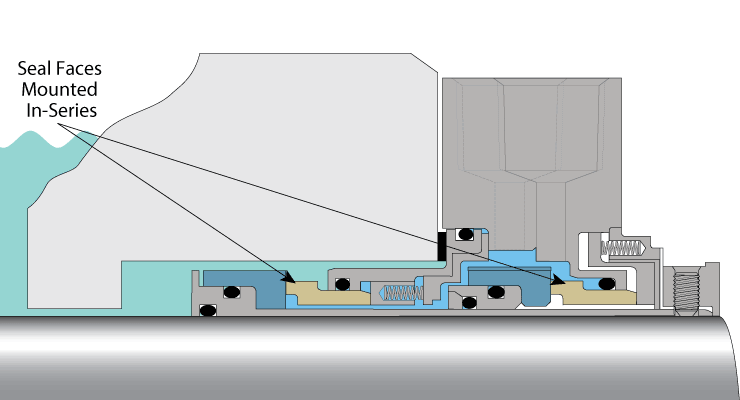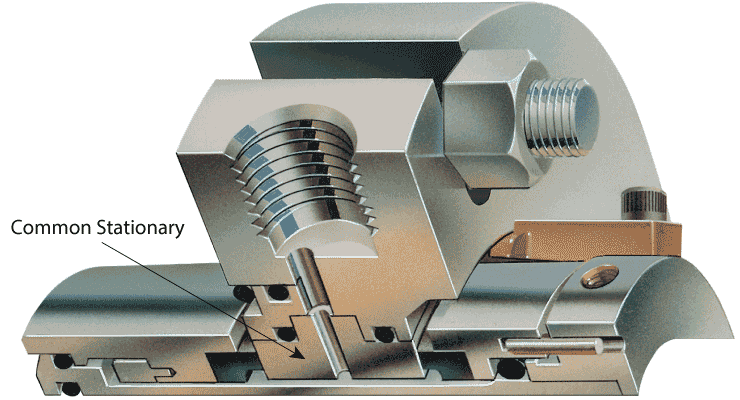
In Part 1 of our series on double (dual) seals, we discussed the benefits of dual seal design and when to use it. In Part 2, we’re taking a closer look at the various rotary and stationary double seal arrangement options (configurations), and how to maximize their success.
A double seal is designed with two primary seals. These seals often use two rotating seal faces and two stationary seal faces. A fluid is provided between these two seals at a lower pressure than the sealed fluid (known as buffer fluid) or at a pressure higher than the sealed fluid (known as barrier fluid). The fluid provided to the dual seal allows the seal to survive in lethal, explosive, carcinogenic, hazardous, adhesive, or extremely viscous fluids.
A conventional double seal can be designed to seal the buffer or barrier fluid on the inside or outside diameter of the seal faces. Typically, the seal designer will place a softer, narrow face against a harder, wide seal face. The design intention is to enable the softer seal face to wear, while keeping the wider hard face from wearing in service. Once the narrow seal face has been worn away, the seal has reached the end of its suitable life.
There are three ways seal faces are configured / arranged in double mechanical seals: Back-to-Back, Tandem, and Face-to-Face.
Each configuration has its own strengths which are addressed below. Ultimately, it’s best to speak with a sealing specialist who can draw on a wealth of direct experience and implement according to your organizations’ expectations for reliability and environmental compliance.
Back-to-Back Double Seal Arrangement

Figure 1: Back-to-back Double Mechanical Seal Arrangement
In this double seal configuration, two narrow seal faces are mounted back-to-back (opposing) to one another. This is the original concept of a dual seal —taking two component mechanical seals and placing them ‘back-to-back’ within the stuffing box. This configuration is used in most general applications.
Advantages
- Outboard seal provides full pressure back-up
- Short axial length
- Unified face alignment (less possible in the tandem configuration)
- Non-fretting
- Reverse pressure balanced if double-balanced
- Available in cartridge options for easier installation/flexibility
Disadvantages
- Limitation on barrier fluid pressure capability
- Does not handle reverse pressure (unless double balanced)
- Product dilution
How It Works
- To operate correctly, Back-to-Back configurations normally require barrier fluid (pressure higher than the sealed fluid).
- The unbalanced back-to-back mechanical seal requires a barrier fluid pressure of 15 psig higher than the seal chamber pressure. The barrier fluid is being pressurized above the seal chamber pressure, so the outboard seal faces are carrying the greater load and should wear out or fail first. When this happens, the barrier pressure will be lost, causing the inboard faces to open. In other words – if the seal works correctly, both seals will fail at the same time. This is not very good back-up protection.
- If this seal is a double balanced design, the fluid between the inboard and outboard seal faces can be higher (barrier) or lower (buffer) pressure than the seal chamber pressure. This means that if the barrier/buffer fluid is lost, both seals will remain closed and operate reliably.
- In back-to-back arrangement (both unbalanced and balanced seal designs), the outboard seal faces almost always are rated for a lower pressure than the inboard seal faces. This is because the outboard seal faces are an outside seal configuration and the faces are exposed to tensile force. Ceramics are generally weaker in tension than compression, so their pressure limit is lower.
- Under normal operation, there is no risk of leakage to the atmosphere.
- Fluid level change in the barrier fluid tank indicates the condition of the seal.
- If the nature of the operation is critical, a fluid level switch should be installed in the seal support system.
- If the inboard seal fails first, the barrier fluid will leak into the process which will cause product dilution. This product dilution sometimes is not desirable for products that can not tolerate it.
Tandem Mechanical Seal Arrangement

Figure 2: Tandem Double Mechanical Seal Arrangement
This configuration occurs when two sets of seal rings are identically orientated and mounted in-series. This configuration is often referred to as the “in-series seal face arrangement” or “face-to-back.” It is commonly used in dual seals.
Advantages
- High pressure (barrier fliud) capability
- Outboard seal provides full pressure back-up – making this the best choice for sealing toxic or dangerous fluid/gases
- Handles solids and contaminated media
- Very popular in oil refinery applications
Disadvantages
- Longer axial length than the back-to-back seal arrangements (This can be a problem where space is limited on process equipment).
- Complex design, often expensive.
How It Works
- Tandem seals increase system reliability by allowing the outboard seal to take over should the inboard seal fail in a critical application.
- Enhanced reliability is possible due to the fact that the inboard and outboard seal faces are arranged identically as a pair of inside seals.
- Inside seals seal product on the outer diameter of the seal faces. This is more desirable arrangement for seal reliability.
- In this arrangement, the seals position the barrier or buffer pressure on the outside diameter of the outboard face. The pressure acts to compress the outboard seal faces. This allows a higher barrier fluid pressure.
Face-to-Face Double Seal Arrangement

Figure 3 – Face-to-Face Double Mechanical Seal Arrangement
Face-to-face seals can be used when the equipment is space constrained to accommodate a back-to-back or tandem seal arrangements. In this configuration a portion of the seal is mounted in the seal chamber and the remainder is mounted outside of the seal chamber.
Advantages
- Simple design
- Allows for more axial travel
- Handles solids and contaminated media
- Can operate in buffer or barrier fluid configuration
- Often not located entirely within the stuffing box
- Fairly common due to ease of manufacture and low cost.
Disadvantages
- Outboard seal does not provide full pressure back-up
- Most use a common stationary component. Reliability is sacrificed, because if the stationary breaks both sets of seal rings fail.
How It Works
- The inboard seal acts as an inside seal, but the outboard seal acts as an outside seal.
- Inside mechanical seals seal product on the outer diameter of the seal faces. This is a more desirable arrangement for seal reliability.
- Outside mechanical seals seal product on the inside diameter which is not desirable for seal reliability.
For successful seal life and reliability it is very important to have the right seal arrangement along with the right barrier/buffer fluid system. In upcoming blogs, we will discuss various seal environmental control plans available for double seals and how to select the best barrier / buffer fluid for good seal life to achieve maximum reliability.
Next in This Series:
- Part 3: Support Plans for Double/Dual Mechanical Seals
- Part 4: How to Select the Best Barrier/Buffer Fluid for Your Application
- Part 5: Saving Water with Double Seals
